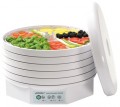Tray size
Horizontal dimensions of one dryer tray.
For round models, this paragraph usually indicates the diameter (for example, “Ø250”), for other cases — the length and width. Anyway, the information about the size allows you to estimate the total area and, accordingly, the capacity of the device. At the same time, note that a larger size affects the dimensions and weight of the structure, and also requires more heating power (ceteris paribus).
Total capacity
The total volume of all dryer trays. The larger the volume, the more products can be loaded into the device at a time. For modern dryers, a capacity of
up to 10 L is considered relatively small,
from 11 to 15 L — medium,
from 16 to 20 L — high, and the largest models can hold
more than 20 L.
Note that if you plan to dry several different types of fruits or vegetables at the same time, it is worth considering not only the total volume of the dryer, but also the number of trays (see above).
Power consumption
Rated power consumed by the dryer during operation.
This parameter is usually selected by manufacturers depending on the volume of the dryer: the larger the device, the more power is needed to effectively heat the working chamber. At the same time, models with the same volume may differ in power consumption. In such cases, it is worth considering that a higher power reduces the heating time, but affects the price of the device.
Tray for marshmallow
Availability
of a tray for a marshmallow in a set of delivery of the dryer.
Such a device differs from ordinary trays in the design of the bottom — it is solid, without openings. This is due to the fact that the raw material for the preparation of marshmallows is fruit puree, which simply would not have stayed on the classic grating bottom. Most often, there is only one tray for marshmallows, however, in some models it may be possible to purchase additional trays of this type.
We emphasize that it is undesirable to use such accessories for more traditional ingredients (pieces of vegetables, fruits, etc.): in some cases this reduces the drying efficiency, in others it can lead to damage to the contents.
Mesh for herbs and spices
A mesh for herbs and spices is included in the delivery set of the food dehydrator.
These meshes are characterized by a finely porous structure to prevent herbs and spices from falling through the mesh holes. They are made of silicone or stainless steel, and more rarely of bamboo. There are also variants with non-stick coating, which prevents food from sticking to the surface of the mesh.
Temperature range
The temperature range that the dryer can provide in the working chamber.
The simplest models provide only one operating temperature option, usually from 50 °C to 60 °C. More advanced devices equipped with thermostats (see above) and can have a wide range of adjustment — this is very useful, because different temperature regimes are recommended for different products. To assess the general capabilities of a particular dryer, you can use the following table of temperatures recommended for drying:
— 35...40 °C — plant stems, greens;
— 40...45 °C — bread;
— 38...42 °C (in some cases up to 45 °C) — yoghurt;
— 50...55 °C — vegetables;
— 55...60 °C — fruits;
— 65...75 °C — meat, fish.
We emphasize that these are the most general, conditional data. The specific temperature may differ from the recommended one — depending on the thickness of the slices, the specific type of food, the desired result, etc. Detailed recommendations on this matter can be found in special sources.

